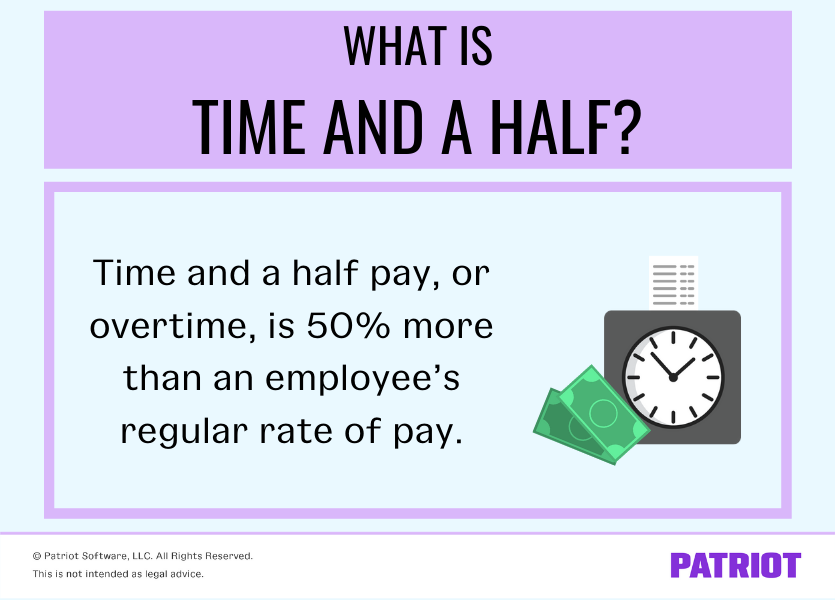If you have nonexempt employees, you have to pay them overtime, or time and a half, for any hours worked over 40 during the workweek. Learn all about time and a half, who qualifies for overtime, and how to calculate it.
What does time and a half mean?
Again, when an employee works overtime hours, you must pay them time and a half their regular rate of pay. This may be called overtime, overtime rate of pay, or an overtime premium.
How much is time and a half? Time and a half pay is 50% more than an employee’s regular rate of pay. For every hour of overtime an employee works, you must give them their regular rate of pay plus half of that. To calculate an employee’s overtime rate of pay, multiply their regular rate by 1.5.
The Fair Labor Standards Act (FLSA) regulates overtime. According to the FLSA, you must pay time and a half to employees who work more than 40 hours in a workweek.
But, not all employees receive overtime pay. An employee’s ability to receive time and a half depends on whether they are exempt or nonexempt.

Exempt and nonexempt employees
So, how do you know if an employee is exempt vs. nonexempt? Based on FLSA guidelines, there are a few telltale signs to look out for. Exempt vs. nonexempt varies depending on the following factors:
- If the employee is hourly or salaried
- The salary amount the employee receives
- The employee’s job duties
FLSA rules apply to nonexempt employees. Exempt employees are exempt from the FLSA.
The main difference between nonexempt and exempt employees is that nonexempt employees can earn overtime pay and exempt employees cannot. Take a look at a breakdown of how they differ below.
Exempt employees
Employees are exempt from the FLSA if they:
- Make at least $35,568 annually (or $684 per week)**,
- Receive a salary, AND
- Have job duties that are considered exempt
**On July 1, 2024, a new overtime rule will increase the salary threshold from $35,568 to $43,888. There will be another increase on January 1, 2025, to $58,656.
Exempt job duties include high-level responsibilities that directly affect the company’s overall operations, such as executive, administrative, professional, or computer-based duties.
Additionally, if you pay an employee an annual salary of $107,432 or more, they are exempt if they have at least one executive, administrative, or professional job duty.
There is also a test for employees who work in outside sales. If an employee’s primary duty is making sales, they are exempt. The employee must also regularly perform work away from your business. They do not have to meet salary exemption requirements to be exempt.
Nonexempt employees
On the flip side, nonexempt employees:
- Do not make at least $35,568 annually
- Are not salaried and/or
- Do not have exempt job duties (e.g., administrative)
If you have nonexempt employees, you must pay them time and a half (1.5 times) for any hours worked over 40 a week.
There’s a common misconception that paying an employee a salary means they’re exempt from overtime wages. You can have salaried nonexempt employees who are eligible for overtime pay.
Your state may have stricter overtime laws than the FLSA. Check with your state to learn about the overtime laws you need to follow.
How to calculate time and a half
Again, pay nonexempt employees time and a half for any overtime hours they work. Learn how to track employee hours with software or another reliable alternative for accurate payroll.
A good chunk of nonexempt employees receive hourly wages instead of a salary. However, because nonexempt employees can be salaried, you must know how to calculate time and a half for both salaried and hourly employees.
Hourly employees
Let’s say you have a nonexempt hourly employee who earns $12 per hour. During the last workweek, the employee worked 45 hours (40 regular hours + 5 overtime hours).
To calculate time and a half for the hourly employee, follow these steps:
- Calculate the employee’s regular earnings
- Find the time and a half pay rate (1.5 x Regular Hourly Wage)
- Multiply the overtime rate by the number of overtime hours
- Add together the regular and overtime wages
To find the employee’s regular earnings, multiply their regular pay rate ($12) by 40 hours.
$12 X 40 = $480 in regular wages
Next, calculate the employee’s time and a half pay rate. Multiply 1.5 by the employee’s regular rate of pay.
1.5 X $12 = $18 per hour of overtime
Multiply the overtime rate from above ($18) by the number of overtime hours the employee worked during the week.
$18 X 5 = $90 of overtime pay
Last but not least, add the employee’s regular wages and overtime pay together to find the employee’s total wages. You owe the employee $570 in total gross wages ($480 + $90).
If your employee has multiple pay rates for different jobs within your company, you must calculate weighted overtime for their wages.
Salaried employees
When it comes to calculating time and a half for salaried employees, there are two methods you can use. The method you use depends on if the employee receives a salary that covers a fixed number of hours or if they receive a salary that covers all worked hours (aka fluctuating workweek).
Salary with fixed hours
For a salaried employee with fixed hours, use these steps:
- Calculate the employee’s regular hourly rate
- Calculate the employee’s regular earnings
- Find the time and a half pay rate (1.5 x Regular Hourly Wage)
- Multiply the overtime rate by the number of overtime hours
- Add together the regular and overtime wages
Say your salaried employee earns $1,000 per week. You expect the employee to work 34 hours this week, but they wind up working 45.
First things first, you need to find the employee’s regular hourly rate. Divide the employee’s salary by the number of hours you expected the employee to work (34 hours).
$1,000 / 34 hours = $29.41
Calculate the employee’s regular wages using the rate from above. Multiply the hourly rate by 40 to get the employee’s total regular wages.
$29.41 X 40 hours = $1,176.40
Next, find the employee’s overtime rate by multiplying their regular hourly rate by 1.5.
$29.41 X 1.5 = $44.12
Multiply the employee’s overtime hours by the overtime rate of $44.12.
$44.12 X 5 hours = $220.60
Finally, add together the salaried employee’s regular and overtime wages to get their total gross pay for the period.
$1,176.40 + $220.60 = $1,397
Your employee’s gross wages for the period are $1,397.
Salary with all hours worked
Calculate all hours worked the same way you would calculate fluctuating workweek overtime. Employees who work a fluctuating workweek work a different number of hours from week to week.
Say your employee earns $1,000 a week and their salary covers all hours worked, no matter how many hours they work. The employee worked 48 hours this week.
Calculate the employee’s regular hourly rate by dividing the weekly salary by the total number of hours worked.
$1,000 / 48 hours = $20.83
Because you already accounted for the overtime hours once in the regular hourly rate, you must multiply the regular rate of pay by 0.5 instead of 1.5.
$20.83 X 0.5 = $10.42
Multiply your employee’s overtime hours (8 hours) by their overtime hourly rate ($10.42).
$10.42 X 8 hours = $83.36
As usual, add together the employee’s overtime and regular wages to get their total gross pay for the period.
$1,000 + $83.36 = $1,083.36
Your employee earned $1,083.36 in gross wages for the period.
Don’t make calculating each employee’s overtime wages a hassle. When you use Patriot Software’s easy-to-use payroll software, we’ll do the calculations for you. And, we guarantee accuracy. Give it a try for free today!
This article was updated from its original publication date of November 23, 2014.
This is not intended as legal advice; for more information, please click here.




